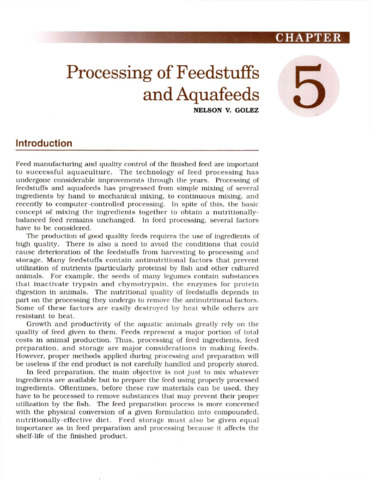Processing of alternative feed ingredients in aquaculture feed
| dc.contributor.author | Teruel, Myrna B. | |
| dc.contributor.author | Glencross, Brett | |
| dc.contributor.editor | Catacutan, Mae R. | |
| dc.contributor.editor | Coloso, Relicardo M. | |
| dc.contributor.editor | Acosta, Belen O. | |
| dc.date.accessioned | 2016-08-08T09:45:47Z | |
| dc.date.available | 2016-08-08T09:45:47Z | |
| dc.date.issued | 2015 | |
| dc.identifier.citation | Teruel, M. B., & Glencross, B. (2015). Processing of alternative feed ingredients in aquaculture feed. In M. R. Catacutan, R. M. Coloso, & B. O. Acosta (Eds.), Development and Use of Alternative Dietary Ingredients or Fish Meal Substitutes in Aquaculture Feed Formulation : Proceedings of the ASEAN Regional Technical Consultation on Development and Use of Alternative Dietary Ingredients or Fish Meal Substitutes in Aquaculture Feed Formulation, 9-11 December 2014, Nay Pyi Taw, Myanmar (pp. 97-104). Tigbauan, Iloilo, Philippines: Aquaculture Department, Southeast Asian Fisheries Development Center. | en |
| dc.identifier.isbn | 9789719931058 | |
| dc.identifier.uri | http://hdl.handle.net/10862/2998 | |
| dc.description.abstract | Fish meal and fish oil have been used worldwide in aquaculture feed formulations. Production of these ingredients has been relatively constant for decades. However, supplies of industrial fisheries are limited, and unlikely to be able to support increasing demand for these products for a growing aquaculture industry. Finding alternative ingredients therefore, is necessary to address the long-term sustainable growth of aquaculture globally, thereby meeting projected increases in consumer demand for safe, high quality farmed aquatic food. Potential alternative ingredients have been identified, mostly coming from plant-derived nutrient sources, such as seeds, grains, leaves and other agricultural by-products. The use of these alternative ingredients however, may cause anti-nutrient inclusion in the feedstuffs that may interfere with feed utilization and affect the health and production of farmed aquatic products. To get rid of these anti-nutrients, and at the same time improve their nutritive value, various processing techniques (e.g. soaking, moist/dry heat treatment, chemical treatment, dehulling, fermentation), among others may be applied to these ingredients prior to use. Specific obstacles to the use of these ingredients will be the type of treatment, processing procedures and methods required to enhance the nutritive value of the product. Proper evaluation of processed feed ingredients in consideration of factors such as ingredient characterization and functionality, digestibility, palatability, nutrient utilization and/or interference of utilization, influence on immune status and organoleptic qualities, and economic viability need to be done to support their potential effective use in diet formulation. These alternative feed ingredients may offer sound potential when used in the right application. The priorities and future directions of feed manufacturing and researches on alternative feed ingredients with application of proper processing procedures are discussed in this report. The correct use of alternative ingredients with proper application of the right processing techniques may confer significant nutritional and technical advantages to the feed design and management process and may result in high quality feeds for healthy sustainable aquaculture. | en |
| dc.language.iso | en | en |
| dc.publisher | Aquaculture Department, Southeast Asian Fisheries Development Center | en |
| dc.title | Processing of alternative feed ingredients in aquaculture feed | en |
| dc.type | Conference paper | en |
| dc.citation.spage | 97 | |
| dc.citation.epage | 104 | |
| dc.citation.conferenceTitle | Development and Use of Alternative Dietary Ingredients or Fish Meal Substitutes in Aquaculture Feed Formulation : Proceedings of the ASEAN Regional Technical Consultation on Development and Use of Alternative Dietary Ingredients or Fish Meal Substitutes in Aquaculture Feed Formulation, 9-11 December 2014, Nay Pyi Taw, Myanmar | en |
| dc.subject.asfa | feeding | en |
| dc.subject.asfa | fishmeal | en |
| dc.subject.asfa | feeds | en |
| dc.subject.asfa | aquaculture development | en |
| dc.subject.asfa | aquaculture | en |
| dc.subject.asfa | sustainability | en |
| dc.subject.asfa | fish oils | en |
| dc.subject.asfa | feed composition | en |
このアイテムのファイル
このアイテムは次のコレクションに所属しています
-
Development and Use of Alternative Dietary Ingredients or Fish Meal Substitutes in Aquaculture Feed Formulation [18]
Proceedings of the ASEAN Regional Technical Consultation on Development and Use of Alternative Dietary Ingredients or Fish Meal Substitutes in Aquaculture Feed Formulation





